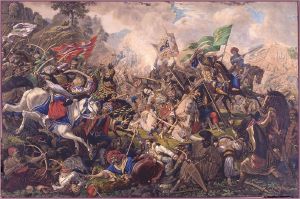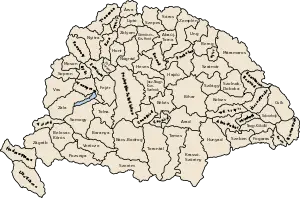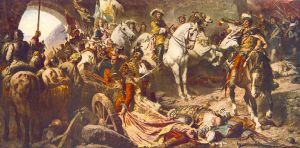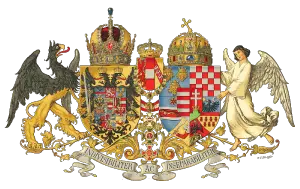Kingdom of Hungary
The Kingdom of Hungary (short form: Hungary), which existed from 1000 to 1918, and then from 1920 to 1946, was a state and at times a major power in Central Europe. Situated between East and West and a significant player in the Balkans it often took the brunt of invasion and conquest. In 1241, it fell to the Mongol invasion of Europe but recovered independence when the Mongols withdrew. From 1541 until 1699 Hungary was divided between the Ottoman Empire and Austria. It is a predecessor state of the Republic of Hungary. In 1699, the whole kingdom was annexed by the Habsburgs. A war of independence took place 1848-1849, which Hungary lost. However, discontent with Habsburg domination continued until the Compromise of 1867 created a dual-monarchy. The Habsburg Emperor remained king but governance was largely delegated to the Hungarian parliament. The political entity known as Austria-Hungary continued until the end of World War I, when the empire was dismantled. Hungary lost considerable territory and entered a period of civil strife as communists vied with democrats and royalists to control the state. From 1920 until 1946, Hungary was de jure a monarchy under a regent but de facto a republic with a Prime Minister heading the executive branch of government. In 1931, a Fascist regime took power that aligned itself with the Third Reich, then entered World War II on the side of the Axis powers.
When the Allies won the Second World War, Hungary was occupied by the Soviet Union, and became a puppet state. This officially ended the Hungarian monarchy. After the Soviet-bloc collapsed in 1989, Hungary became a democratic republic. Hungary joined the European Union in 2004. Due to territorial loss and migration, Hungarians live on both sides of the border. Consequently, they have favored trans-nationalism as a mechanism to secure peace and stability. Although the majority of Hungarians are Magyars, Hungary has a long tradition of giving asylum to others and immediately following the Mongol defeat had encouraged immigration, including Jews. Throughout the Soviet period, the Jewish seminary in Hungary served the entire Eastern bloc. Situated on the border of East and West, the Hungarian space seen occupation, invasion, foreign rule and civilizational conflict. Yet Hungary has also served as a cultural bridge, often maintaining relations with both the East and the West. Hungarians have refused to divide the world into "us" and "them" with the former representing good and the latter evil. Hungarians have tended to see humanity as one family, favoring cooperation and unity over conflict, even though their sensitive geo-political location has attracted a great deal of the latter.
Names
In the late middle ages, the Latin terms "Natio Hungarica" and "Hungarus" referred to all of the population, as loyalty and patriotism towards the crown existed among all inhabitants, regardless of ethnic origins. However, according to Istv√°n WerbŇĎczy's Tripartitum, the "Natio Hungarica" referred only to the privileged noblemen (regardless of ethnicity), as subjects of the Holy Crown of Hungary. The Tripartitum "emphasized the fact that sovereignty resided collectively in this Natio Hungarica, that was united with the state through the Holy Crown of St. Stephen (Wandycz 1992, 58). The Tripartitum dates from 1514 and was commissioned by King Vladislas II to codify the law of the Hungarian kingdom.</ref>
The Latin (Regnum meaning kingdom); Regnum Marianum (Kingdom of St. Mary); or simply Hungaria was the form used in official documents from the beginning of the kingdom to the 1840s.
The German name Königreich Ungarn was used from 1849 to the 1860s, and the Hungarian name Magyar Királyság was used in the 1840s, and again from the 1860s to 1918.
History
The territories of medieval Hungary were second to the Holy Roman Empire and its population was the third largest in Europe.
The Kingdom of Hungary consisted of present-day Hungary, Slovakia, Transylvania (in present-day Romania), Carpatho-Ruthenia (in present-day Ukraine), Vojvodina (in present-day Serbia), Burgenland (in present-day Austria), the Kingdom of Slavonia (part of Croatia), and other smaller territories surrounding present-day Hungary's borders.
Croatia (without Slavonia) had autonomy between 1091 and 1868 within, and then between 1868-1918 in personal union with Hungary.
The √Ārp√°d dynasty
The first kings of the Kingdom were from the √Ārp√°d dynasty and the first Christian King was Stephen I of Hungary who was canonized as a Catholic saint. He fought against Kopp√°ny and in 998, with Bavarian help, defeated him near Veszpr√©m.
The Roman Catholic Church received powerful support from Stephen I, who with Christian Hungarians and German knights wanted a Christian kingdom established in Central Europe, not least of all as a bulwark against the Muslim world. Stephen created the Hungarian heavy cavalry as an example for Western European powers.
After his death, a period of revolts and conflict for supremacy ensued between the royalty and the nobles. In 1051, armies of the Holy Roman Empire tried to conquer Hungary, but they were defeated at Vértes mountain and at Pozsony in 1052.
The second greatest Hungarian king, also from the √Ārp√°d dynasty, was Ladislaus I of Hungary, who stabilized and strengthened the kingdom. He was also canonized as a saint. Under his rule Hungarians successful fought against the Cumans and conquered Croatia in 1091. After Ladislaus, the next famous king of the √Ārp√°d dynasty was Coloman of Hungary, who conquered Dalmatia. Under reign of B√©la III of Hungary the Kingdom rose to be the equal of any European state in the twelfth century. In 1222, Andrew II of Hungary issued the Golden bull which laid down the principles of law.
Mongol invasion
Hungary had given refuge to people fleeing from Mongol conquests in Russia, so presented a possible threat to the Mongol Empire. In 1241, the Mongols invaded Hungary and while the first minor battles ended in Hungarian victories, the Mongols finally destroyed the Hungarian army at the Battle of Mohi.
The Mongols attacked Hungary with three armies. One of them attacked through Poland in order to withhold possible Polish auxiliaries and defeated the army of Duke Henry II the Pious of Silesia at the Legnica. A southern army attacked Transylvania, defeated the voivod (military commander) and crushed the Transylvanian Hungarian army. The main army led by Khan Batu and his general, Subutai attacked Hungary through the fortified Verecke Pass and annihilated the army led by the count Palatine on March 12, 1241.
The Hungarians had known from various sources that the Mongols were coming. Notable heralds of the oncoming invasion include followers of Friar Julian, who warned the king about impending invasion having established contact with Magna Hungaria (Magyars who had not migrate to Hungary) and saw the aftermath of the destruction of both the Magna Hungaria and Volga Bulgaria earlier in the thirteenth century.
In 1242, after the end of the Mongol invasion, Béla IV of Hungary set about reconstructing the country, building numerous fortresses to defend against future invasion. In gratitude, the Hungarians acclaimed him as the "Second Founder of the Homeland." Under Béla, the Hungarian Kingdom again became a considerable force in Europe. Béla delegated authority to the provinces and encouraged immigration to help rebuild the economy, reversing his pre-Mongol invasion policy of centralization. Jews were among those invited. He granted them civil rights at a time when Jews were treated as royal property throughout Europe; "The enactment of King Béla of the basic charter for Hungarian Jewry seems to have been part of his program of reconstruction with the intention of luring additional Jews in order to provide economic vitalization" (Chazan, 201). In 1260, Béla IV lost the War of Babenberg Succession when his army was defeated at Battle of Kressenbrunn by the united Czech troops. However, after 1278, Ladislaus IV of Hungary and Austrian troops fully destroyed the Czech army at the Battle on the Marchfeld.
In 1301, with the death of Andrew III of Hungary, the √Ārp√°d dynasty died out. The dynasty was replaced by the Angevins, followed by the Jagiellonians, and then by several non-dynastic rulers, notably Sigismund, Holy Roman Emperor and Matthias Corvinus.
The first Angevin king was Charles I of Hungary, born in Naples. He implemented considerable economic reforms, and defeated the remaining opposition to royal rule by the nobility, led by Matthew Cs√°k. He was related to the √Ārp√°d through his grandmother, who married Charles II of Anjou, King of Naples (Moln√°r 2001, 41). Louis I the Great succeeded him. Louis I met with success on the battlefield when he defended the Hungarian Kingdom from new attacks by lesser Mongol forces in the latter half of the fourteenth century.
The Hunyadi family
The Hungarian kingdom's golden age was during the reign of Matthias Corvinus, the son of John Hunyadi. His nickname was "Matthias the Just," but it is only legend. He further improved the Hungarian economy and practiced astute diplomacy in place of military action whenever possible. Matthias did undertake campaigning when necessary. In 1485, aiming to limit the influence and meddling of the Holy Roman Empire in Hungary's affairs, he occupied Vienna for five years. After his death, Vladislaus II of Hungary of the Jagiellonians was placed on the Hungarian throne.
At the time of initial Ottoman encroachment, the Hungarians successfully resisted conquest. John Hunyadi was leader of the Long campaign where the Hungarians tried to expel the Turks from the Balkan, early time it was successful, but finally they had to withdraw. In 1456, John Hunyadi, the father of Matthias Corvinus, delivered a crushing defeat on the Ottomans at the Siege of Nándorfehérvár. The Noon bell remembers the fallen Christian warriors; during the war, the Pope ordered all church bells to be rung at noon to call all believers to prayer on behalf of the Hungarian defenders of the borders of Christendom. In the fifteenth century, the Black Army of Hungary was a formidable modern mercenary army, with the most skilled troops of the Hungarian cavalry were the hussars. In 1479, under the leadership of Pál Kinizsi, the Hungarian army destroyed the Ottoman and Wallachian troops at the Battle of Breadfield. As long as Matthias was king, the Army of Hungary almost always defeated the Ottomans.
However, in 1526, at the Battle of Moh√°cs, the forces of the Ottoman Empire annihilated the Hungarian army and in trying to escape, Louis II of Hungary drowned in the Csele Creek. P√°l Tomori, leader of the Hungarian army, also died in the battle.
Ottoman occupation
Due to Ottoman pressure, central authority collapsed and a struggle for power broke out. The majority of Hungary's ruling elite elected John Z√°polya (November 10, 1526) as king. A small minority of aristocrats sided with Ferdinand I, Holy Roman Emperor, who was Archduke of Austria, and was related to Louis by marriage. Due to previous agreements that the Habsburgs would take the Hungarian throne if Louis died without heirs, Ferdinand was elected king by a rump diet in December 1526.
On February 29, 1528, King John I of Hungary received the support of the Ottoman Sultan. A three-sided conflict ensued as Ferdinand moved to assert his rule over as much of the Hungarian kingdom as he could. By 1529, the kingdom had been split into two parts: Habsburg Hungary and "eastern-Kingdom of Hungary." At this time there were no Ottomans on Hungarian territories. In 1532, Nikola JuriŇ°ic defended KŇĎszeg and stopped a powerful Ottoman army. By 1541, the fall of Buda marked a further division of Hungary into three areas. Even with a decisive 1552 victory over the Ottomans at the Siege of Eger, which raised the hopes of the Hungarians, the country remained divided until the 1699.
Although the borders shifted frequently during this period, the three parts can be identified, more or less, as follows:
- Royal Hungary, which consisted of territories adjacent to the Hapsburgs' Austrian holdings. These were present day Slovakia, north-western Transdanubia, Burgenland, western Croatia, some non-contiguous territories (counties), and this defined the continuity of the Kingdom of Hungary. Though nominally this remained a separate state, it was administered as part of the Habsburgs' Austrian holdings and thus effectively became under Habsburg rule.
- The Great Alföld (most of present-day Hungary, including south-eastern Transdanubia and the Banat), partly without north-eastern present-day Hungary, became part of the Ottoman Empire.
- The remaining territory became the newly independent principality of Transylvania, under Zápolya's family. Transylvania was a vassal state of the Ottoman Empire. In 1644, the Winter Campaign took place when Miklós Zrínyi burnt the crucial Bridge of Eszék, a Turkish supply line in Hungary.
At Battle of Saint Gotthard (1664) Austrians and Hungarians defeated the Turkish army. After a failed Ottoman invasion of Austria in 1683, the Habsburgs went on the offensive against the Turks and by the end of the seventeenth century, they managed to conquer the remainder of the historical Kingdom of Hungary and the principality of Transylvania. For a while in 1686, Buda the capital again became free with European help.
Habsburg dominance
After the departure of the Ottomans, the Austrians dominated the Hungarian Kingdom. The Hungarians' renewed desire for an independent Hungary brought about R√°k√≥czi's War for Independence. On of the most important reasons for the war were new and higher taxes. Francis II R√°k√≥czi was a Hungarian noble, son of Ilona Zr√≠nyi the legendary heroine and regent of Transylvania who led a three year anti-Austrian rebellion (Moln√°r 2001, 131). R√°k√≥czi spent part of his youth in Austrian captivity. His troops were called the Kurucs, or crusaders. Initially, the Kuruc army attained several important victories due to their superior skilled light cavalry. Their weapons were mostly pistols, light saber and fokos (axes). At the Battle of Saint Gotthard (1705), Kuruc general J√°nos Botty√°n decisively defeated the Austrian army. The famous Hungarian colonel √Ād√°m Balogh nearly captured the Emperor of Austria. In 1708, the Habsburgs finally defeated the main Hungarian army at Battle of Trencin. This weakened the effectiveness of the Kuruc army. While the Hungarians were exhausted by the fighting, the Austrians defeated the French army in the War of the Spanish Succession then sent more and more troops to Hungary against the rebels from West.
The next ruler of Hungary was the Austrian Emperor Charles VI, who settled numerous Vlach ethnic groups in Transylvania. From this time on, the designation Royal Hungary was abandoned, and the area was once again referred to as the Kingdom of Hungary. Throughout the eighteenth century, the Kingdom of Hungary had its own Diet (parliament) and constitution, but the members of the Governor's Council (Helytartótanács, the office of the palatine were appointed by the Habsburg monarch, and the superior economic institution, the Hungarian Chamber, was directly subordinated to the Court Chamber in Vienna. The Hungarian Language reform started under reign of Joseph II. The reform age of Hungary was initiated by István Széchenyi a Hungarian count, who built one of the greatest bridges of Hungary the Széchenyi Chain Bridge, founded the Hungarian Academy of Sciences which he also financed.
The official language of the Kingdom of Hungary remained Latin until 1844. Then, between 1844 and 1849, and from 1867, Hungarian became the official language.
The European revolutions of 1848 swept Hungary as well. The Hungarian Revolution of 1848 sought to redress the long suppressed desire for political change, namely independence. The Hungarian National Guard was created by young Hungarian patriots in 1848. In literature, this was best expressed by the greatest poet of the Revolution, S√°ndor PetŇĎfi. One of the most famous battles was on September 29, 1848, at the Battle of P√°kozd. When Serbs attacked the Hungarians in the South, a great general called ErnŇĎ Kiss stopped three Serbian regiments with only 72 hussars.
As war broke out with Austria, Hungarian military successes, which included the brilliant campaigns of the great Hungarian general, Art√ļr G√∂rgey, forced the Austrians on the defensive. Fearing defeat, the Austrians pleaded for Russian help, which, combined with Austrian forces, quelled the revolution. The desired political changes of 1848 were again suppressed until the Austro-Hungarian Compromise of 1867.
Austria-Hungary
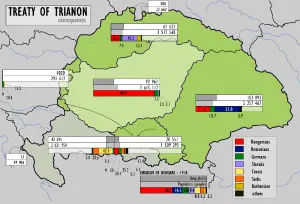
Following the Austro-Hungarian Compromise of 1867, the Habsburg Empire became the "dual monarchy" of Austria-Hungary, often referred to as the Austro-Hungarian Empire.
The Austro-Hungarian economy changed dramatically during the existence of the dual monarchy. Technological change accelerated industrialization and urbanization. The capitalist way of production spread throughout the Empire during its fifty-year existence and obsolete medieval institutions continued to disappear. By the early twentieth century, most of the Empire began to experience rapid economic growth. The GNP per capita grew roughly 1.45 percent per year from 1870 to 1913. That level of growth compared very favorably to that of other European nations such as Britain (1.00 percent), France (1.06 percent), and Germany (1.51 percent).
The historic lands of the Hungarian Crown (the Kingdom of Hungary proper, to which Transylvania was soon incorporated, and Croatia-Slavonia, which maintained a distinct identity and a certain internal autonomy), was granted equal status with the rest of the Habsburg monarchy. Each of the two states comprising Austria-Hungary exercised considerable independence, with certain institutions, notably the reigning house, defense, foreign affairs, and finances for common expenditures, remained under joint management. This arrangement lasted until 1918, when the Central Powers were defeated in World War I.
The new borders set in 1920 by the Treaty of Trianon, ceded 72 percent of the historically Hungarian territory of the Kingdom of Hungary to the neighboring states. The beneficiaries were Romania, and the newly formed states of Czechoslovakia and the Kingdom of Serbs, Croats and Slovenes. This left millions of ethnic Hungarians outside the new borders, contrary to the terms laid out by United States President Woodrow Wilson's Fourteen Points, which had honored the ethnic makeup of the territories.
Kingdom of Hungary between 1920-1944
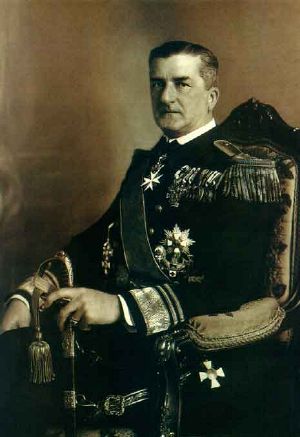
After the pullout of occupation forces in 1920, the country went into civil conflict, with Hungarian anti-communists and monarchists purging the nation of communists, leftists and of others they thought represented a threat. Later in 1920, a coalition of right-wing political forces united, and reinstated Hungary's status as a constitutional monarchy. Selection of the new King was delayed due to civil infighting, and a regent was appointed to represent the monarchy, former Austro-Hungarian navy admiral Miklós Horthy.
The Kingdom of Hungary, which existed from 1920 to 1944, was a de facto regency under Regent Miklós Horthy, who officially represented the abdicated Hungarian monarchy. Attempts by Charles IV King of Hungary (Charles I of Austria, the last Habsburg, to return to the throne, were prevented by threats of war from neighboring countries, and by lack of support from Horthy.
The post-World War I Hungarian state was conceived of as a "kingdom without a king," since there was no consensus on either who should take the throne of Hungary, or what form of government should replace the monarchy. The first ten years of this reinstated kingdom saw increased repression of the Hungarian minorities, uncharacteristic of Hungary's historical legacy. Limits on the number of Jews permitted to go to university were placed, and corporal punishment was legalized. Under the leadership of Prime Minister István Bethlen, democracy dissipated as Bethlen manipulated elections in rural areas which allowed his political party, the Party of Unity to win elections repeatedly. Bethlen pushed for the revision of the Treaty of Trianon, but after the collapse of the Hungarian economy between 1929 to 1931, the national uproar pushed Bethlen to resign. When Gyula Gömbös became Prime Minister in 1932, he allied Hungary with Germany. He was the first head of government to visit Adolf Hitler following Hitler's rise to power. Gömbös introduced anti-Jewish legislation and took Hungary into World War II on the side of the Axis Powers.
In 1944, Horthy appointed an anti-fascist Prime Minister who attempted a defection to the Allied powers. However, the Hungarian army ignored an armistice signed on October 15, 1944 with the Soviets and continued to fight. This resulted in Hungary being occupied and dissolved by Nazi Germany, and replaced by a briefly-existing puppet state. In January 1955, the Soviets entered and occupied Hungary. By 1949 a Soviet-satellite state, the People's Republic of Hungary, had been established. However, during 1956 a revolt took place in favor of democracy and freedom which was crushed when the Soviet sent troops into Hungary. When the Soviet-bloc collapsed in 1989, the democratic Republic of Hungary replaced the communist state. The Republic of Hungary joined the European Union in 2004.
Legacy
In today's Hungary, the Kingdom of Hungary is regarded as one long stage in the development of the state. This sense of continuity is reflected in the republic's national symbols, holidays, official language, and the capital city of the country and in the short form of the country's name in Hungarian, (Magyarorsz√°g) the same. The millennium of the Hungarian statehood was commemorated in 2000, and codified by the Millennium Act of 2000.
One significant legacy of the Kingdom of Hungary that continues to impact the modern nation-state of Hungary is that Hungary is a bridge between East and West while "International migration has played a crucial role in Hungary's history since its foundation as a state in the 10th century." A key feature of Hungary is that it is "a sending, transit, and destination country for migration." Judit Juh√°sz comments:
Hungary's special characteristics are rooted in this history of fluid borders, as well as the strong migratory tendencies of people of Hungarian ancestry who are citizens of neighboring countries. Today, mainly as a result of these factors, roughly three million ethnic Hungarians live in nearby countries. The country's geographical location, which has placed it in the path of important European events, is also key. Moreover, the current nature of Hungary's economy and society, which are in transition, offers special opportunities to migrants, especially those from eastern Europe.[1]
Although during the period of Habsburg domination many Hungarians of Magyar descent resented what amounted to a Germanization process and despite the anti-Jewish measures introduced under the Fascists, Hungary has a proud and long history of recognizing all who are loyal to the state as Hungarian, regardless of ethnicity. Even during the Soviet period, Hungary maintained a Jewish seminary, the only one East of the Berlin Wall.[2] Situated on the border of East and West, the Hungarian space seen occupation, invasion, foreign rule and civilizational conflict. Yet, Hungary has also served as a cultural bridge, often maintaining relations with both the East and the West. Hungarians have almost always refused to divide the world into "us" and "them" with the former representing good and the latter evil. Hungarians have tended to see humanity as one family, favoring cooperation and unity over conflict, even though their sensitive geo-political location has seen a great deal of the latter.
See Also
Notes
- ‚ÜĎ Judit Juh√°sz, 2003, Hungary: Transit Country Between East and West, Washington, DC: Migration Policy Institute. Retrieved January 21, 2009.
- ‚ÜĎ George Sch√∂pflin, 1986, The Soviet Union and Eastern Europe. Handbooks to the modern world. New York, NY: Facts on File. ISBN 9780584700060. 611.
ReferencesISBN links support NWE through referral fees
- Engel, P√°l. 2001. The realm of St. Stephen: a history of medieval Hungary, 895-1526. London, UK: I.B. Tauris. ISBN 9781860640612.
- Kontler, László. 2002. A history of Hungary: millennium in Central Europe. Houndmills, Basingstoke, Hampshire, UK: Palgrave Macmillan. ISBN 9781403903167.
- Molnár, Miklós. 2001. A concise history of Hungary. Cambridge concise histories. Cambridge, UK: Cambridge University Press. ISBN 9780521661423.
- Saunders, J.J. 1971. The history of the Mongol conquests. New York, NY: Barnes & Noble. ISBN 9780389044512.
- Sugar, Peter F., Péter Hanák, and Tibor Frank. 1990. A History of Hungary. Bloomington, IN: Indiana University Press. ISBN 9780253355782.
- Wandycz, Piotr Stefan. 1992. The price of freedom: a history of East Central Europe from the Middle Ages to the present. London, UK: Routledge. ISBN 9780415076265.
Credits
New World Encyclopedia writers and editors rewrote and completed the Wikipedia article in accordance with New World Encyclopedia standards. This article abides by terms of the Creative Commons CC-by-sa 3.0 License (CC-by-sa), which may be used and disseminated with proper attribution. Credit is due under the terms of this license that can reference both the New World Encyclopedia contributors and the selfless volunteer contributors of the Wikimedia Foundation. To cite this article click here for a list of acceptable citing formats.The history of earlier contributions by wikipedians is accessible to researchers here:
The history of this article since it was imported to New World Encyclopedia:
Note: Some restrictions may apply to use of individual images which are separately licensed.

